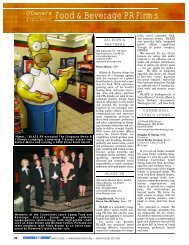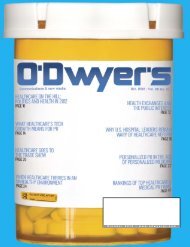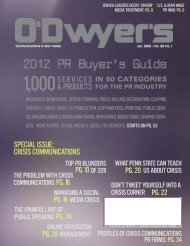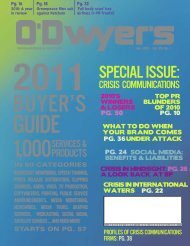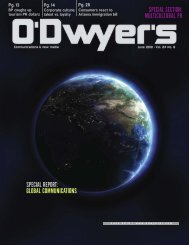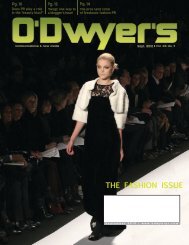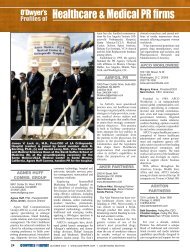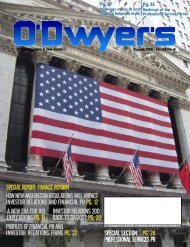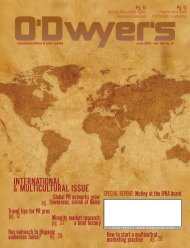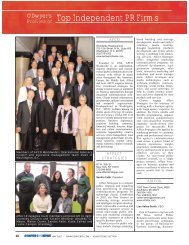PR Firm Rankings - Odwyerpr.com
PR Firm Rankings - Odwyerpr.com
PR Firm Rankings - Odwyerpr.com
Create successful ePaper yourself
Turn your PDF publications into a flip-book with our unique Google optimized e-Paper software.
Coal mine <strong>PR</strong> spinning U.S. public, Congress<br />
By Rene A. Henry<br />
Every time I hear the news about a coal<br />
mine disaster it brings back many old<br />
memories.<br />
I was born and raised in West Virginia,<br />
with ancestors whose backgrounds were in<br />
glass making and railroading,<br />
not coal.<br />
Sadly, the <strong>PR</strong> and lobbying<br />
<strong>com</strong>panies that<br />
work for mining <strong>com</strong>panies<br />
have kept the<br />
regulatory, oversight<br />
and enforcement agencies<br />
weak and safety<br />
standards below expec-<br />
Rene A. Henry is the<br />
author of seven books.<br />
He lives in Seattle.<br />
tations. They have<br />
done a great job of<br />
spinning the facts.<br />
The most recent explosion<br />
that killed 29 miners at Massey<br />
Energy’s Upper Big Branch Mine in<br />
Montcoal, W.V., is one example. The mine<br />
was cited for two safety violations just one<br />
day before the disaster and a total of 57<br />
times in March, mainly for poor ventilation<br />
of dust and methane.<br />
The U.S. Mine Safety and Health<br />
Administration has cited this mine 1,342<br />
times in the previous five years and proposed<br />
fines of $1.89 million. Massey has<br />
contested 422 of those violations and much<br />
of the enforcement is stalled somewhere in<br />
the regulatory and judicial process.<br />
Don Blankenship, Massey Energy’s<br />
CEO, has called members of Congress<br />
“greeniacs” and said that House Speaker<br />
Nancy Pelosi (D-Calif.) and Senate<br />
Majority Leader Harry M. Reid (D-Nev.)<br />
“don’t know what they’re talking about.”<br />
The leadership and most members of<br />
Congress continue to ignore the facts, hear<br />
only the spin, and do nothing to speed<br />
enforcement and pass tougher safety standards.<br />
One of my first experiences dealing with<br />
a coal mine disaster was November 1954,<br />
when I was Sports Information Director at<br />
West Virginia University.<br />
Our football team had just defeated<br />
William & Mary 20-6 and our flight was<br />
ready to leave Newport News, Virginia.<br />
The editor of a leading newspaper who<br />
was traveling with us had just received news<br />
that there was an explosion in Jamison Mine<br />
No. 9. This affected several members of the<br />
team but none more than Sam Huff. Had the<br />
explosion happened one hour earlier, he<br />
would have been the only surviving male in<br />
his family.<br />
Huff, who grew up in the Jamison Mine<br />
No. 9 Coal Camp in a rowhouse with no<br />
running water, was the first in his family to<br />
ever graduate from college. His football<br />
skills earned him an athletic scholarship,<br />
otherwise he would have be<strong>com</strong>e a coal<br />
miner. He is in both the College and NFL<br />
Pro Football Halls of Fame. He also was the<br />
first NFL player to be featured on the cover<br />
of Time.<br />
An explosion on November 20, 1968,<br />
took the lives of 78 miners. Huff lost five<br />
relatives. The bodies of 19 miners who perished<br />
were never recovered and the mine<br />
was permanently sealed. Black lung caused<br />
the death of Huff’s youngest brother when<br />
he was only 60 years old.<br />
For five years, when I headed <strong>com</strong>munications<br />
and government relations for the<br />
mid-Atlantic states region of the U.S. EPA,<br />
we faced the challenge of <strong>com</strong>municating<br />
the destruction of the environment caused<br />
by mountaintop mining.<br />
This is a type of strip mining where entire<br />
mountaintops are cut away by explosives<br />
and giant machines bury hundreds of miles<br />
of what once were pure mountain streams,<br />
causing permanent loss of ecosystems.<br />
In 2008, the Bush Administration rolled<br />
Guest Column<br />
back and redefined regulations making it<br />
more profitable for coal operators. These are<br />
being contested by advocacy groups.<br />
One story I heard years ago, but cannot<br />
confirm, is how one <strong>com</strong>pany hired a New<br />
York <strong>PR</strong> firm to help with its image and<br />
labor problems. The United Mine Workers<br />
were campaigning to organize the workers<br />
in one particular West Virginia mine.<br />
When the miners demonstrated, the <strong>com</strong>pany<br />
brought in hired thugs from Detroit<br />
and Chicago to physically beat them. To<br />
counter the negative image it was receiving,<br />
the coal <strong>com</strong>pany worked with its <strong>PR</strong> firm<br />
to take another course of action — to dynamite<br />
a railroad bridge leading to the mine<br />
and blame it on the local miners.<br />
The <strong>PR</strong> firm brought in an explosive<br />
demolition team as well as a photographer<br />
to provide photos to the media. The bridge<br />
was destroyed but the <strong>PR</strong> man was arrested<br />
by the local sheriff as he was leaving the<br />
site.<br />
The story makes for good fiction, just like<br />
so much of the rhetoric against increasing<br />
mine safety and enforcement.<br />
Based on its response, I’m beginning to<br />
believe Congress believes fiction more than<br />
fact, just like “smoking is good for you” and<br />
“the check is in the mail.” <br />
MAY 2010 WWW.ODWYER<strong>PR</strong>.COM 59



